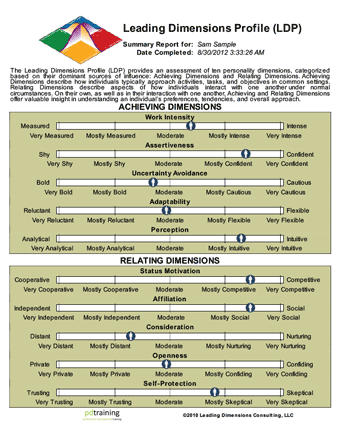The five Achieving Dimensions:

1. Accomplishing Goals
This dimension describes how you pursue goals, whether for personal or work initiatives. While some prefer to work at a steady, balanced pace, others show an intense, urgent pace. Most of us tend to fluctuate between a measured and intense focus at times.
2. Asserting Yourself
This dimension describes how you assert your viewpoint. Some tend to be very quick to assert their opinions and may aspire to lead others. Others tend to be more reserved and defer opportunities to offer their opinion. Most of us seem to dislike public speaking, but will assert ourselves when needed.
3. Taking Risks
This dimension describes how you approach uncertain or risky situations. Some people seem to be natural risk takers, while others tend to be more cautious and careful. Most of us tend to fluctuate somewhere between avoiding and taking risks, depending on the situation.
4. Adapting to Change
This dimension describes how you navigate change. While some of us prefer stability and a predictable environment, others of us enjoy frequent change and lots of variety. For the most part, we tend to display both reluctance and flexibility at times, depending on the significance of the change.
5. Decision-making
This dimension describes how we learn and process information in making decisions. Some tend to rely on their intuition and experience, while others rely on a more analytical approach. Most of us tend to balance both perceptive and analytical approaches to some degree in making decisions.
The five Relating Dimensions are:
1. Competing
This dimension describes how we relate to others as we accomplish goals. While some tend to thrive in competitive settings where they are rewarded for their individual performance, others prefer cooperative efforts and team rewards. Most of us tend to enjoy both opportunities from time to time.
2. Working Together
This dimension describes how we collaborate with others in getting things done. While some of us prefer to go it alone and work independently, others are much more comfortable when they can work together. Most of us tend to work independently or collectively at times, based on the circumstances.
3. Helping Others
This dimension describes how we recognize the feelings and interests of those around us. While some of us go out of our way to learn how we can help others, some of us tend to approach others more formally or objectively. Most of us tend to fluctuate between sensitive and objective approaches.
4. Opening Up
This dimension describes your interest in sharing personal information with others. While some tend to place a high value on privacy and formality, others are much more open in their communication. Most of us tend to be quiet at times, and open up in others, depending on the circumstances.
5. Protecting Yourself
This dimension describes how you tend to view others' intentions or reliability. While some are comfortable giving others the benefit of the doubt, others will be inclined to scrutinize things more carefully. For the most part, we tend to balance trust with skepticism in common situations.